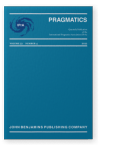Vol. 32:4 (2022) ► pp.588–619
Aspects of væ (‘and’) as a discourse marker in Persian
This study investigates the functions of væ (‘and’) as a discourse marker in Persian. More specifically, this study accounts for certain aspects of væ co-occurrences and their linearization order. Fraser’s model (forthcoming) was mainly employed to classify the multiple functions conveyed by væ. A corpus-based approach was taken to provide an overview of væ co-occurrences with other discourse markers. The data were collected from both written and spoken corpora. Quantitative and qualitative analyses were conducted to examine the frequency and the functional differences in the use of væ in the data – namely, elaboration, inferential, contrast, and alternation. The results of the study indicate the mobile nature of væ in its co-occurrences with other DMs. The findings also show that some modifications to Fraser’s (forthcoming) DM co-occurrence principles are required to handle certain cases of language-specific behavior of væ in Persian. The configuration suggested for væ uses and its multi-functionality will also shed some lights on cross-linguistic studies of its counterparts in other languages.
Article outline
- 1.Introduction
- 2.Discourse markers and their co-occurrences
- 2.1Discourse markers
- 2.2Discourse marker co-occurrences
- 2.3 væ in Persian
- 3.Data and method
- 4.Functions of væ as a DM
- 4.1Elaborative function
- 4.1.1Addition
- 4.1.2Specification
- 4.1.3Temporal
- 4.2Contrastive function
- 4.3Inferential function
- 4.4Alternative function
- 4.5Topic-shifting function
- 4.1Elaborative function
- 5.Results and discussion
- 5.1Simultaneous multifunctionality of væ
- i.Additional-temporal function
- ii.Additional-contrastive function
- iii.Additional-inferential function
- iv.Specific-contrastive function
- 5.2væ co-occurrences
- 5.1Simultaneous multifunctionality of væ
- 6.Conclusion
- Acknowledgments
- Notes
- List of Abbreviations
-
References
